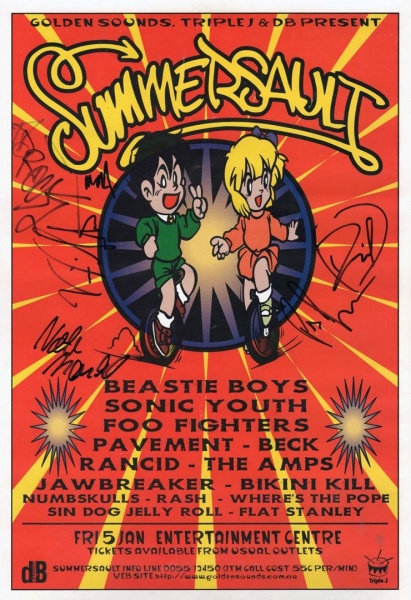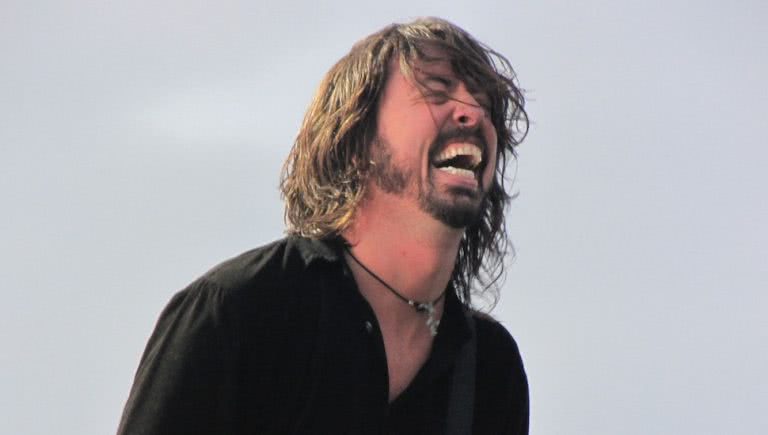Foo Fighters’ self-titled debut album came out on July 4th, 1995.
Foo Fighters are one of the most successful bands of the modern era. In 2018, they earned as much as Drake, which essentially puts them in the upper tier of pop celebrity. And much like Drake (who was a successful child star pre-music career), the claim “started from the bottom, now we’re here,” rings hollow when it comes to the Foos.
No one needs reminding, but Dave Grohl spent the first half of the 1990s playing drums in the biggest rock band in a generation. Grohl joined Nirvana in 1990 and played on their two biggest and most artistically significant LPs, Nevermind and In Utero, as well as 1994’s multi-platinum MTV Unplugged in New York.
But by the time the latter album came out, Nirvana were no more. Kurt Cobain’s death by suicide in April 1994 brought the band to a sudden end, and Grohl was at a loss for what to do next. He had offers to join bands like Danzig and Tom Petty and the Heartbreakers, but pounced on neither.
After doing some recording with Minutmen’s Mike Watt, Grohl became interested in starting his own project. He’d been writing songs for years and even released a cassette album under the pseudonym Late! in 1992. This collection, titled Pocketwatch, featured the song ‘Color Pictures of a Marigold’, which Nirvana later re-recorded as ‘Marigold’ and included as the ‘Heart-Shaped Box’ B-side.
Check out ‘Marigold’ by Nirvana:

So, with a bag of song ideas, Grohl booked six days at Seattle’s Robert Lang Studios, called up Pocketwatch producer Barrett Jones, and got to work on the first Foo Fighters album. “I thought that this would be some sort of cathartic therapy, to go out and record these songs that I’d written by myself,” Grohl said to Q Magazine in 2007.
Love Music?
Get your daily dose of metal, rock, indie, pop, and everything else in between.
Foo Fighters remains a Grohl-led operation to this day, but the project’s first album is effectively a solo album. Aside from some guitar work on ‘X-Static’ courtesy of The Afghan Whigs’ Greg Dulli, Grohl plays every instrument on the record.
This doesn’t prevent Foo Fighters from sounding like the work of a thrashing a rock band, mind you. Album highlights include its opening track, garage rocker ‘This Is a Call’, and the jangly guitar-pop number ‘Big Me’. The seeds of the Foos’ arena rock future can be found in the single ‘I’ll Stick Around’, while Grohl’s goofier side shines through on ‘For All the Cows’.
Check out ‘For All the Cows’ by Foo Fighters:

The album, perhaps predictably, was an instant success. Grohl inked a deal with Capitol Records for its release, which meant despite the no-nonsense production, Foo Fighters benefited from the major label promotional treatment. And it didn’t take long for the band’s name to spread.
Prior to release, Grohl recruited Sunny Day Real Estate’s Nate Mendel and William Goldsmith and took Foo Fighters on the road. The band’s first touring engagement was in support of Watt on his 1995 Ring Spiel Tour. Around this time ‘This Is a Call’ and ‘Exhausted’ started getting radio play. Then, in conjunction with the album’s release, Foos joined Shudder to Think and Wool on their US tour.
Foo Fighters reached no. 23 in the US Billboard 200 and made it all the way to no. 3 in both the UK and Australian ARIA charts. It’s since been certified platinum in the US and UK and Gold in Australia. Foo Fighters played their debut Australian shows in late 1995 as part of Steve Pavlovic’s Summersault tour. Their name was listed just beneath Beastie Boys and Sonic Youth on a lineup that also included Beck, Pavement and Bikini Kill.

Foo Fighters was critically vaunted, too. Rolling Stone‘s Alec Foege gave it four stars, writing that “like Nirvana’s best work, these songs sagely embrace alternative rock’s essential contradiction — this is ‘popular’ music devised by an alienated few.”
Grohl has certainly never disowned the album, but he has expressed misgivings about the vocal performances. “I was insecure about my voice,” he told Q. “You know how people double their vocals to make them stronger? That album the vocals are quadrupled. I didn’t want to be a lead singer, I couldn’t fucking sing.”
But these concerns are largely unfounded. Sure, he can’t match Cobain’s unearthly screech, but Grohl’s melodious gifts are evident in tracks like ‘Exhausted’, ‘Oh, George’ and ‘Big Me’. Meanwhile, the scream that continues to decorate every Foo Fighters live show gets its first airing on ‘I’ll Stick Around’ and ‘Weenie Beenie’.
Foo Fighters would soon solidify into a band and Grohl would refine the songwriting and production of Foo Fighters on 1997’s The Colour and the Shape. But Foo Fighters remains one of the most significant debut albums of its era.
Check out ‘This Is a Call’ by Foo Fighters:


































